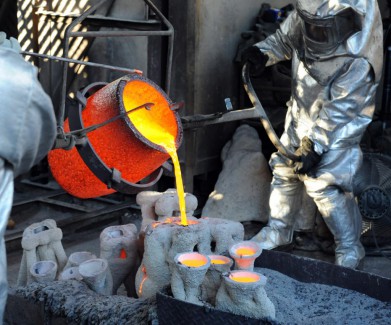The Black Ink Team's Guide To Metalcasting
by Black Ink Team
Metalcasting is the science and art of making metal castings. A ‘casting’ is an object made by pouring a superheated liquid into a mold, which then cools into its final shape. Most metalcasting is performed in foundries. Foundries consist of three areas: one for smelting, one for molding, and one for cleaning.

In the smelting area of a foundry, metal is melted into a liquid. It is also combined with other metals to create ‘alloys’ – combinations of multiple metals that can be stronger, more ductile, more resistant to heat, etc. The metal is melted in a furnace, then transported to the molding area using a ladle.
In the molding area of a foundry, molds are created using ‘patterns’ – copies of the final desired shape for the metal. A mold consists of sand and a container to hold the sand. A pattern gets pressed into sand to create the mold, then once it is removed molten metal gets poured into the mold. If there are hollow parts of the final shape that are desired, such as if you are creating a pipe, then a ‘core’ gets placed at the center of the mold. After the metal poured into the mold cools, it gets moved to the cleaning area.
In the cleaning area of a foundry, castings are taken out of molds. Very rarely is this the final stage of the process, because metal usually doesn’t set perfectly. Additionally, in a process called ‘annealing,‘ metal can be heated up and cooled multiple times (in order to prevent brittleness). Sand and excess metal are removed from the casting, to give it a smooth exterior. Molds can be used again and again.
